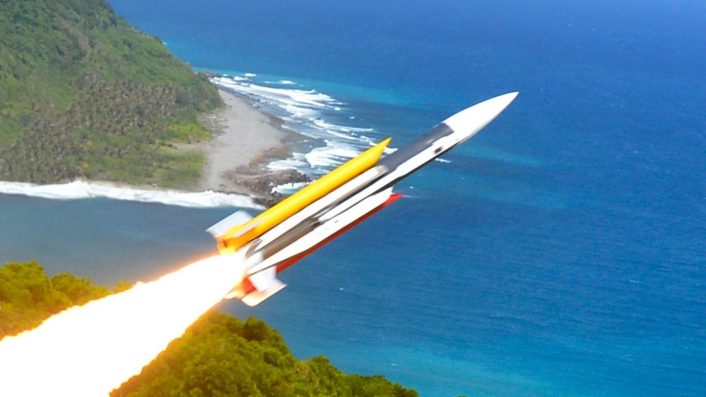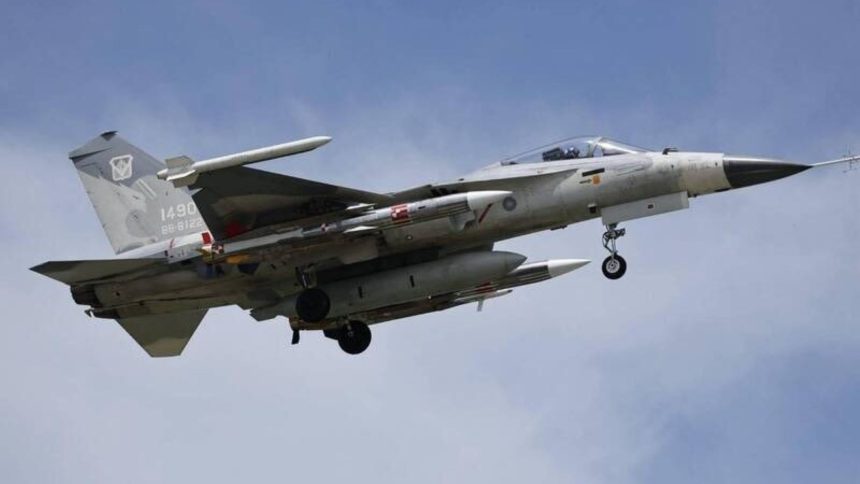Taiwanese reports said that the NCSIST is accelerating the testing to gather data that would inform new live fire trials.
Taiwan’s air-launched Hsiung Feng III (HF-III or HF-3) Anti-Ship Missile (AShM) is now undergoing captive carry and drop trials from the RoCAF’s (Republic of China Air Force) F-CK-1 Ching-kuo IDF (Indigenous Defense Fighter), with tests conducted in June, July and last week this August, according to reports from Liberty Times. The HF-3 is an extended range variant of the HF-2.
The ground-launched coastal defense AShM was modified, according to Taiwan News, to make it “compact” for an air-launch, as part of a program designated ‘Project Xiong Ying’. The changes included bringing its length within 5.5 meters, diameter to 36 centimeters and weight between 900-1,000 kg.
A Liberty Times report on Jun. 19, 2025, showed an IDF with two HF-3s, one on each of the wings, with red-and-white paint scheme bands and numbered AX-001 and AX-004, although we cannot see these designations clearly in the image. The colors and designation indicate these represent test articles.
The missile is missing two of its large side boosters, each with two tail-end fins. These are seen in an official image of the HF-3 when launched from the ground.
Taiwan Air Force F-CK-1A MLU “1490” conducted a drop test of an air-launched HF-3 anti-ship missile test round at Chihhang Air Base, eastern Taiwan, on 8/6.
Picture and info from Liberty Times#Taiwan pic.twitter.com/0N2DmKcpmM
— Taiwan News 247 (@TaiwanNews247) August 9, 2025
On Aug. 10, 2025, Liberty Times published another report with an image of an IDF carrying a single HF-3 with the same type of marking, seen on the starboard (right-side) wing. The colour schemes of the test article in both images is different from the grey paint scheme the HF-3 sported when two of them were initially spotted on an IDF in February 2025.
In both the reports, Liberty Times said that the missile’s developer, NCSIST (National Chung Shan Institute of Science and Technology) is rapidly accelerating through the progressive testing phases to gather aerodynamic and mechanical data that would inform another series of trials, expected to begin on Aug. 15.
HF-3 tests so far
The Liberty Times report on Jun. 19, 2025, capturing the IDF with the two test article HF-3s, observed “bright” and “metallic” silver paints on the weapon, beside its tail control fins also sporting a red-yellow-blue color combination. “It is speculated that the next phase will focus on testing the aerodynamic characteristics of the missile body when it separates from the launcher to confirm the bombing procedure and the operational safety of the launcher,” Liberty Times added.
The report speculated that the next stage might include “radar and remote control projects,” as per the machine translation. This suggests tests of the missile’s guidance, seeker, navigation and what could be interpreted to be a mid-course target-updating capability from the launching IDF via what usually are two-way data links. Liberty Times clarifies that it has not received confirmation from the NCSIST in this regard.
🇹🇼Taiwan’s Xiong Zhi Project, variant of air-launched Hsiung Feng III supersonic anti-ship missile, moving to next stage. 2 air-launched HF-3 variants, AX-001/004 test articles, carried by F-CK-1 spotted today (1) appear different from before (2).
Source: https://t.co/UDF1UX61ze pic.twitter.com/yM2QQKjHU7
— Taiwan Military (@TaiwanMilitary) June 19, 2025
On Aug. 10, Liberty Times said that the NCSIST conducted drop tests of the HF-3 test articles on the Taichung coast in the west-central region in “mid-July”. The report went on to add that on Aug. 6, 2025, an F-CK-1A MLU, tail “1490”, conducted a test drop of the HF-3 at Chihhang Air Base, in the southeastern Taitung region. It then claimed additional simulated missile tests off Taichung will begin on Aug. 15, lasting until the end of the month.
This is what the report said about the subsequent testing stages post-August.
“Military officials pointed out today that the intensive testing of the air-launched Hsiung Feng III anti-ship missile system means that the system is about to enter the test missile stage from the simulation missile stage. After the test is completed in mid-August, it should be able to enter the fighter jet mounting test missile stage in the second half of the year, and will also have combat evaluations such as launch from the launcher, launch simulation to lock on to sea targets, and attack target ships with test missiles and live ammunition.”
It is not clear whether the bit about “jet mounting tests” might also mean that the trials consisted of land-launches or static fire tests of the new missile’s air-breathing ramjet motor after designers dropped its boosters. However, this is unlikely, given that the context is exclusively about an air-launched HF-3 and the photos from June and August published by Taiwanese accounts and Liberty Times showed the IDF carried the missile’s test articles.
🔴 Tayvan’ın Hsiung Feng-3 füzesi küçültülmüş versiyonu ilk kez görüntülendi.
▪️F-CK-1 savaş uçakları tarafından taşınan HF füzesinin hava versiyonu. pic.twitter.com/wxGCy5OQc5
— Kamil Görgülü (@kamilgorgulu1) February 22, 2025
Modification project
Taiwan News reported in December 2023 that, while the IDF possesses the required flight speeds to reach the initial velocity required to fire an air-launched HF-3, NCSIST had to cut the missile’s pre-modification 1,400 kg weight and drop its booster stage. “Two boosters originally outfitted on the Hsiung Feng III missiles have been removed, and the missile body has been moderately downsized and reduced in weight,” Taiwan News said. Reports put the new missile’s weight between 900 and 1,000 kg, minus the two boosters.
According to UDN, the basic version of the missile can reach a speed of Mach 3.5 and touch ranges between 150 km and 300 km. It has been often hailed as a “carrier killer” owing to its high terminal stage speed that reduces the reaction time of the ship.
It is not known if any changes have been made to the warhead, seeker and guidance sections. However, some amount of internal tweaking cannot be ruled out either, with updated circuitry and electronics.
The IDF can carry a maximum payload of 4,000 kg. A lighter HF-3 would also alleviate structural stress on the IDF’s airframe, allowing it to carry other air-to-air missiles for swing-roles, CAPs (Combat Air Patrol), point defense of air bases, or integral defense to RoCAF’s Mirage 2000s and F-16V Block 70s.

It is not yet known whether the NCSIST would produce fresh stocks of air-launched HF-3s minus the boosters following the conclusion of its test campaign, or take existing units from its current stockpile. The latter is however unlikely, given the large armory needed to fend off a Chinese invasion, which would feature a massive air and naval blockade.
Electronic warfare pods for the IDF
Images of a RoCAF C-130H carrying two Electronic Warfare (EW) pods also appeared on Aug. 13. These pods, meant for the IDF, are currently in flight testing before operational fielding under the “Xuan Ji Project,” according to the Formosa Aviation and Military Image Press.
Aiming to give the IDF a sorely lacking dedicated EW capability, the domestically produced pods were tested on the C-130H “at high altitudes and under various flight conditions,” before its “subsequent installation on combat aircraft.” The report added that the pods offer “radar signal detection, electronic jamming, and threat warning capabilities,” to protect the aircraft from radar and missile locks.
The C-130H transport aircraft’s spacious cabin has a dedicated operator station in the rear, recording real time flight data at varying altitudes and speeds to assess the hardware and software performance in complex electromagnetic environments.
🇹🇼”Project Xuan Ji” electronic warfare pod successfully completed flight tests on a C-130H.
The “Xuan Ji Project” is a major R&D initiative to enhance the protective capabilities of the 🇹🇼 F-CK-1 Indigenous Defense Fighters.😎🙏https://t.co/VoBZIexgJC pic.twitter.com/f5ua1oJLB3
— Taiwan Military (@TaiwanMilitary) August 13, 2025
The project faced challenges owing to lack of access to vital components and technologies in the electromagnetic spectrum, because of which Taipei decided to do it alone with an homegrown system. UDN reported that the defense ministry, since 2020, allocated around $135 million in research funding to NCSIST for Project Xuan Ji.









